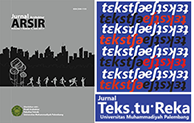Ornamen Rumah Adat Aceh Utara dalam Terminologi Arsitektur
Sari
Along with the times, Indonesian culture is starting to be neglected by various groups, especially the millennial generation. This can be seen in the erosion of culture in a region, especially in the values and meanings contained in carvings on the ornaments of traditional houses of north aceh, so that preservation is needed to inhibit the acceleration of the rate of shift in the value of modern society's life. Cultural preservation is also a process of preserving, maintaining and preserving culture so that the cultural meanings contained in it are maintained properly so as not to eliminate the original character of the culture itself. This study aims to reveal the existence of carvings on ornaments, their general meaning and meaning in architectural semiotics on carvings of traditional houses of Aceh Utara. The data analysis technique used in this research is architectural semiotics which was developed by Charles Jencks, namely signifier-signified which describes the interpretation of meaning, langue-parole which describes universal and individual linguistic meanings and syntagmatic-paradigmatic to analyze the relationship between language rules and rules in grammatical units in the form of carvings on the ornaments. The results and discussion found from this study are the traditional house of North Aceh using the Aceh Besar decorative motif as the basis for its later ornamental carvings which have gone through developments and modifications based on local cultural considerations. Besides that, North Aceh has the bungong mata uroe motif as the original motif from the region. Decorative motifs on ornamental carvings tell about the way of life, the philosophy of life, culture, mores and religion.
Kata Kunci
Teks Lengkap:
PDF (English)Referensi
Abdillah, T. R. (2016). Kajian Semiotika dan Estetika Ornamen pada Reuncong Aceh: Studi Kasus pada Rencong Meupucok, Pudoi dan Meucugek.
Am, Z., Ismawan, I., & Lindawati, L. (2018). Ragam motif dan makna yang terdapat pada kupiah riman di Desa Adan Meunasah Dayah Kecamatan Mutiara Timur Kabupaten Pidie. Jurnal Ilmiah Mahasiswa Pendidikan Seni, Drama, Tari & Musik, 3(2).
Anisa, S. C. (2019). Penelusuran makna simbol nanas pada masa lalu di Belanda dari material culture Delfts Blauw [Universitas Indonesia]. https://lib.ui.ac.id/detail?id=20482217&lokasi=lokal
Bhayangkara, C. S. (2022). Ini lambang sila ke-3 pancasila dan maknanya yang wajib diketahui seluruh masyarakat Indonesia. Suara.Com. https://www.suara.com/news/2022/01/20/093620/ini-lambang-sila-ke-3-pancasila-dan-maknanya-yang-wajib-diketahui-seluruh-masyarakat-indonesia#:~:text=1.-,Pohon Beringin yang Besar,berguna sebagai tempat untuk berteduh.
Fitrah, T. A. (2021). Semiotika pinto Aceh [Universitas Islam Negeri Ar-Raniry]. https://fdokumen.id/dokumen/10bcb_semiotika-pinto-aceh.html
Jazuli, A. K. (2016). Tinjauan Mashlahah Terhadap Perlindungan Seni Ukir Melalui Indikasi Geografis. Jurisdictie, 7(1), 22.
KBBI daring. (2016). Pelestarian. Badan Pengembangan Dan Pembinaan Bahasa. https://kbbi.kemdikbud.go.id/entri/pelestarian
Kholisya, U. K. (2019). Representasi kosmologi Jawa pada gapura kontemporer di desa-desa kabupaten Karanganyar. Cakrawala-Jurnal Humaniora, 19(1), 113–120.
Kodariyah, R. (2019). Aku cinta saudaraku: Tengku dan Cut. Pacu Minat Baca. https://books.google.co.id/books?id=VRpeCwAAQBAJ
Maulin, S., Zuriana, C., & Lindawati, L. (2019). Makna motif ragam hias pada rumah tradisional Aceh di museum Aceh. Jurnal Ilmiah Mahasiswa Pendidikan Seni, Drama, Tari & Musik, 4(1), 81–93.
Mentri dalam negri dan mentri kebudayaan dan pariwisata. (2009). Peraturan bersama mentri dalam negri dan mentri kebudayaan dan pariwisata. 3. https://danisuluhpermadi.web.id/wp-content/uploads/2021/03/PBM-Mendagri-Menbudpar_42-40_2009_Pedoman-Pelestarian-Kebudayaan.pdf
Muktiono, A. (2020). Mengungkap pesan semiotika arsitektur rumah Si Pitung. IKRA-ITH Teknologi: Jurnal Sains & Teknologi, 4(1), 32–41.
Nahak, H. M. I. (2019). Upaya melestarikan budaya indonesia di era globalisasi. Jurnal Sosiologi Nusantara, 5(1), 65–76.
Natasya, N. (2020). Tipologi motif ornamen pada arsitektur rumah vernakular desa Lubuk Sukon dan Lubuk Gapuy Aceh Besar. Jurnal Ilmiah Desain & Konstruksi, 18(2), 170–183.
Octaviola, D. (2019). Tenun songket Nyak Mu di Gampong Siem Kecamatan Darussalam Kabupaten Aceh Besar [Institut Seni Budaya Iindonesia Aceh]. http://isbiaceh.ac.id/wp-content/uploads/2020/10/dina-octaviola.pdf
Raehana, R. (2021). Identifikasi ragam hias tradisional Aceh Besar. Jurnal Ilmiah Mahasiswa Pendidikan Kesejahteraan Keluarga, 6(2), 1–17.
Soetriono, R. H., & Hanafie, R. (2007). Filsafat ilmu dan metodologi penelitian. Yogyakarta: Andi Offset.
Thabroni, G. (2019). Arsitektur: pengertian, fungsi, unsur & tugas (pendapat ahli). Serupa.Id. https://serupa.id/arsitektur-pengertian-fungsi-unsur-tugas-pendapat-ahli/
DOI: https://doi.org/10.32502/arsir.v6i2.5282
Refbacks
- Saat ini tidak ada refbacks.
Indexed by:

Arsir : Jurnal Arsitektur is lisenced under a Creative Commons Attribution-ShareAlike 4.0 International License.









